Covid, fragile alarm in autumn. Gimbe Report

Data, comments and scenarios in the monitoring of the Gimbe Foundation on the pandemic trend and vaccination campaign.
Fragile alarm in autumn.
"With the arrest of the descent of cases and with a very large vulnerable population, without a preparation plan for the autumn-winter season, there is a risk of compromising the health and life of the most vulnerable people".
This is the comment of the president of the Gimbe Foundation, Nino Cartabellotta, who accompanies the dissemination of the new independent monitoring on the trend of Covid in Italy.
«If in the electoral campaign – underlines Nino Cartabellotta – which monopolized public information, the pandemic found a place only for political exploitation, the data show that we are facing the autumn-winter season in an unfavorable situation. First of all, the descent of the fifth wave seems to have stopped and in the height of summer the viral circulation is still very high compared to previous years: as of August 23, over 750,000 positives (a number widely underestimated), a positivity rate of antigenic swabs at 17.4 % and an average of over 25,000 new cases per day. Secondly, the population at risk of serious illness is very large: as of 24 August, taking into account over 60 and frail, gross of temporarily protected people recovered, there are 893,000 unvaccinated, 1.91 million without a third dose and 14.3 million without fourth dose whose administration campaign suffers a sensational delay. Finally, no preparation plan has yet been made public for the autumn-winter season, strongly advocated by the Gimbe Foundation in the wake of the recommendations of the WHO Europe : to increase vaccination coverage (with three doses) in the general population; offer the fourth dose to people at risk 120 after the administration of the third; promote the use of masks indoors and on public transport; ventilate crowded public spaces, such as schools, offices, bars and restaurants, public transport; apply rigorous therapeutic protocols for people at risk of serious illness. In the absence of certainty about when the new Executive will be fully operational, the real risk is that of being in the middle of the autumn season chasing the virus for the umpteenth time, compromising the health and life of the most vulnerable people and delaying health care. for patients with other pathologies ".
+++
HERE IS THE FULL REPORT OF THE GIMBE FOUNDATION ON THE PANDEMIC TREND AND VACCINATION CAMPAIGN:
The independent monitoring of the Gimbe Foundation detects in the week 17-23 August 2022, compared to the previous one, an increase in new cases (177,877 vs 149,885) (figure 1) and a substantial stability of deaths (759 vs 746) (figure 2). Currently positive cases are decreasing (752.091 vs 854.023), people in home isolation (745.459 vs 846.180), hospitalizations with symptoms (6.378 vs 7.544) and intensive care (254 vs 299) (figure 3). In detail, compared to the previous week, the following changes were recorded:
- Deaths: 759 (+ 1.7%), of which 80 referred to previous periods
- Intensive care: -45 (-15.1%)
- Hospitalized with symptoms: -1,166 (-15.5%)
- Home isolation: -100,721 (-11.9%)
- New cases: 177,877 (+ 18.7%)
- Currently positive cases: -101.932 (-11.9%)
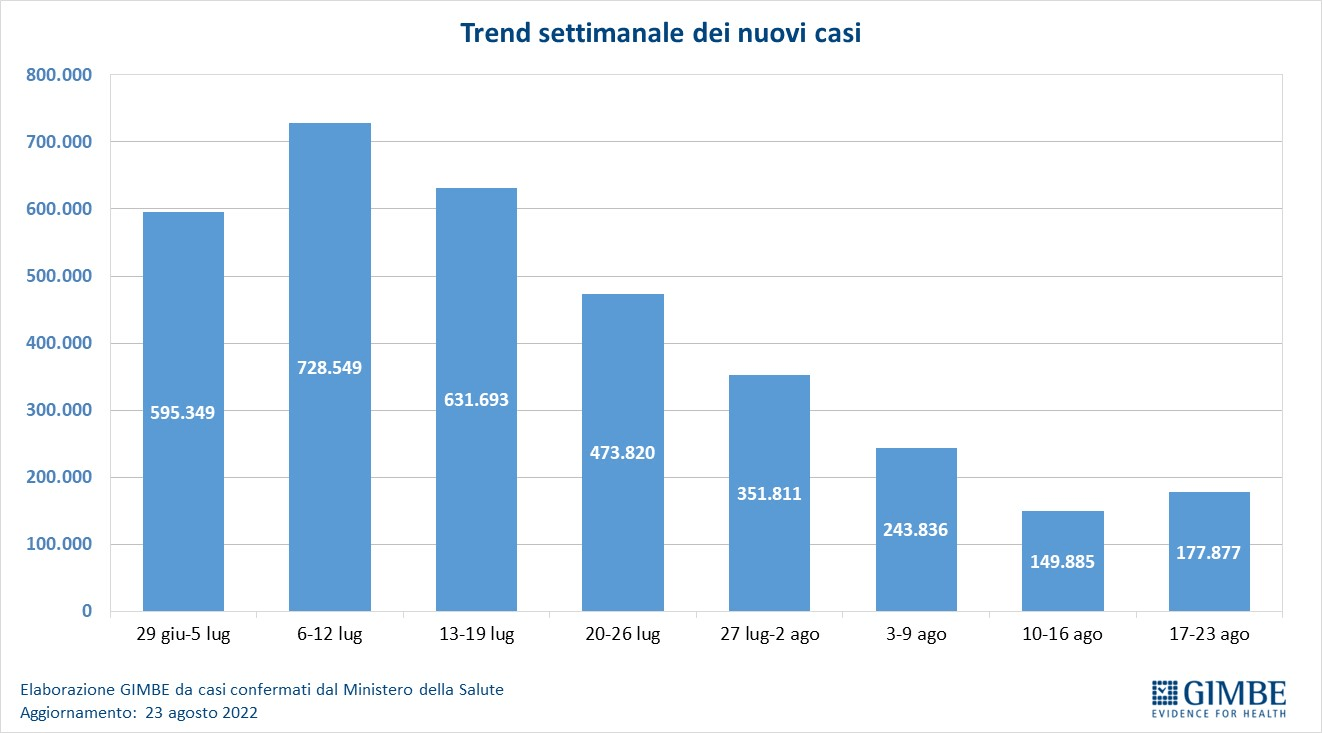
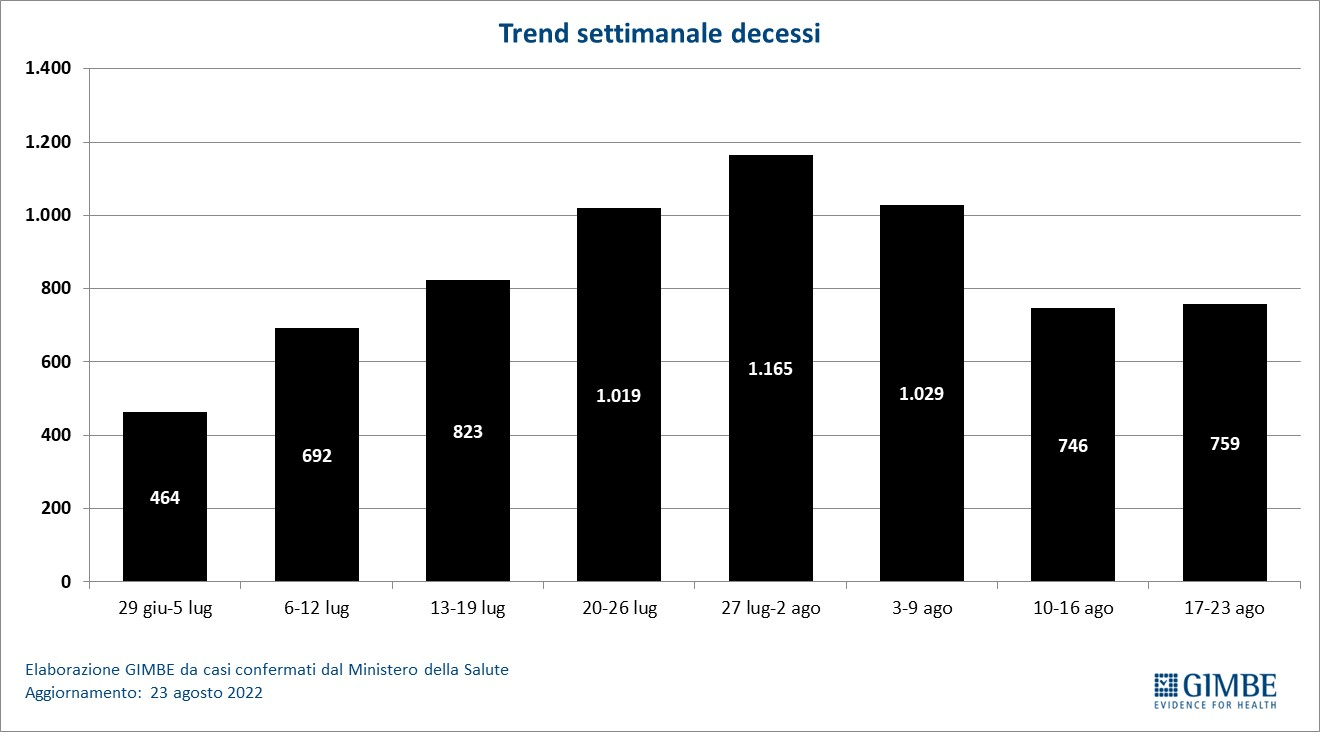
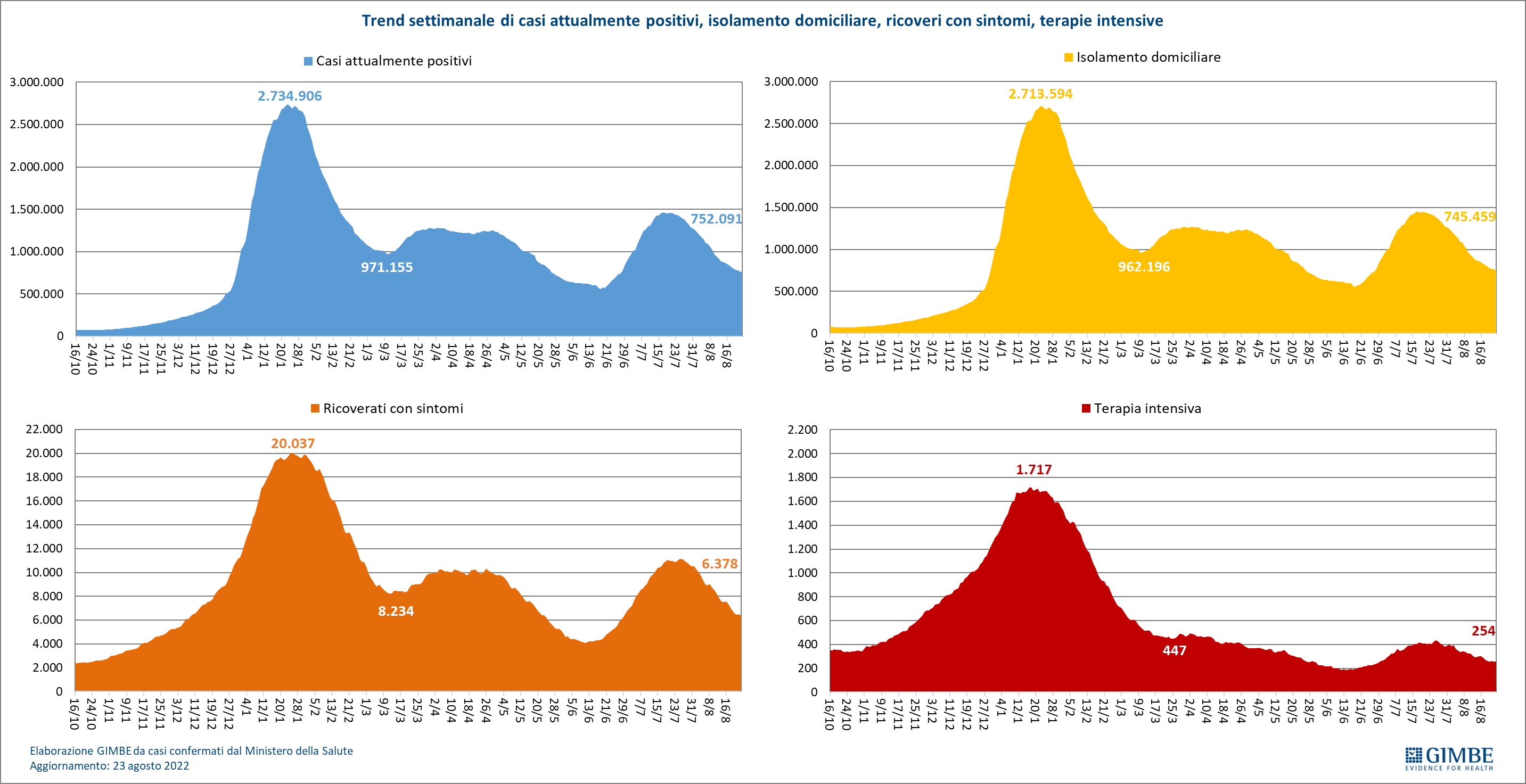
New cases. «After five weeks of decline – declares Nino Cartabellotta, President of the Gimbe Foundation – the number of new weekly cases starts to grow again (+ 18.7% compared to the previous week). A reversal of trend due in part to the "rebound" resulting from the lower number of infections detected in the long weekend of August, in part to the likely increase in viral circulation ». In the week 17-23 August, the new cases touched 178 thousand, with a 7-day moving average of over 25 thousand cases per day (figure 4); in all Regions, with the exception of Emilia-Romagna (-9.1%) and Umbria (-0.4%), there was a percentage increase in new cases (from + 8.1% in Liguria to +56.4 % of Calabria) (table 1). Compared to the previous week, in 95 Provinces there is an increase in new cases (from + 1.8% in Catania and Trapani to + 79.4% in Catanzaro), in the remaining 12 Provinces there is a decrease (from -0.1 % of Savona to -25% of Forlì-Cesena). The incidence exceeds 500 cases per 100,000 inhabitants in 6 Provinces: Crotone (784), Catanzaro (728), Vibo Valentia (652), Pescara (617), Belluno (528) and Teramo (522) (table 2).
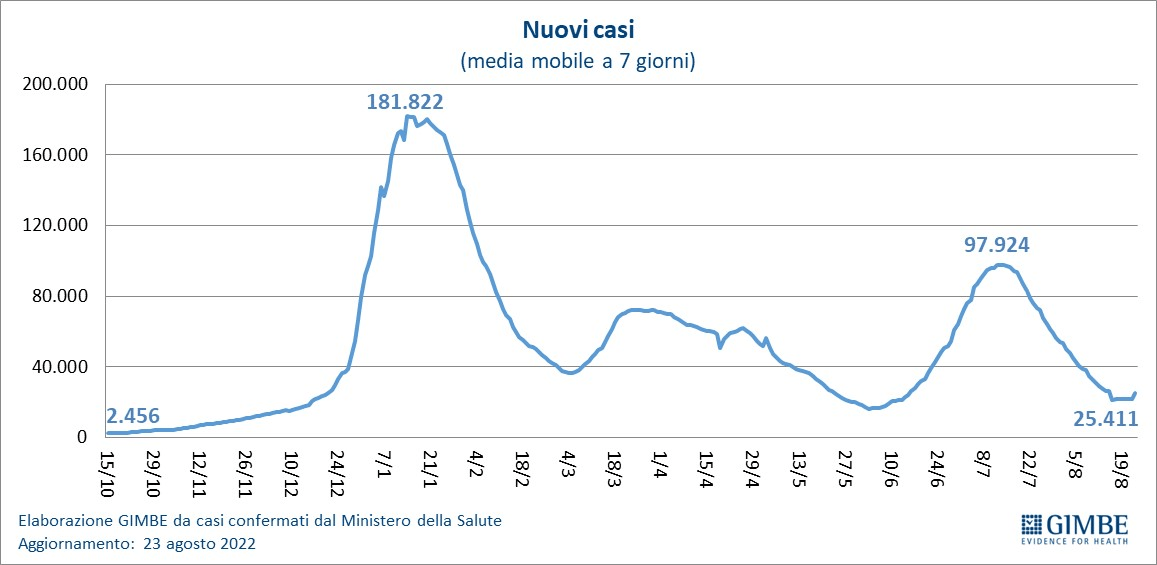
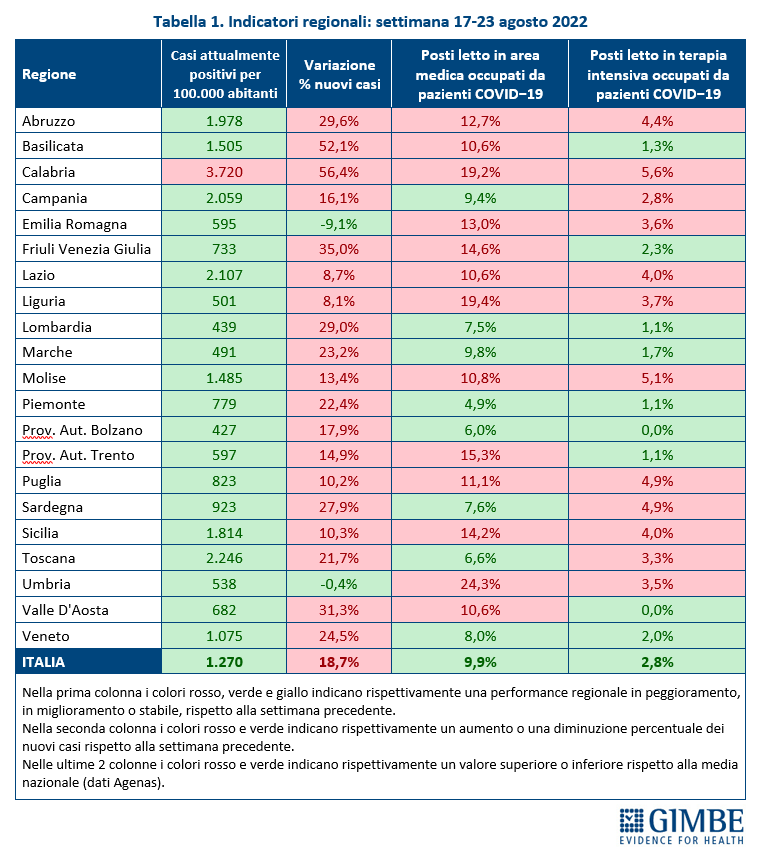

Reinfections . According to the latest report from the Istituto Superiore di Sanità , over 983,000 reinfections were recorded in Italy in the period 24 August 2021-17 August 2022, equal to 5.8% of the total cases. Their incidence in the week 10-17 August was 12.94% (24,102 reinfections), a slight decrease compared to the previous week (13.44%).
Testing. There was an increase in the number of total tampons (+ 9.5%): from 1,012,546 in the week of 10-16 August to 1,109,070 in the week of 17-23 August. In particular, rapid buffers increased by 9.3% (+77.507) and molecular buffers by 10.5% (+19.017) (figure 5). The 7-day moving average of the positivity rate rises from 8.9% to 10.4% for molecular buffers and from 16.2% to 17.4% for rapid antigens (Figure 6).
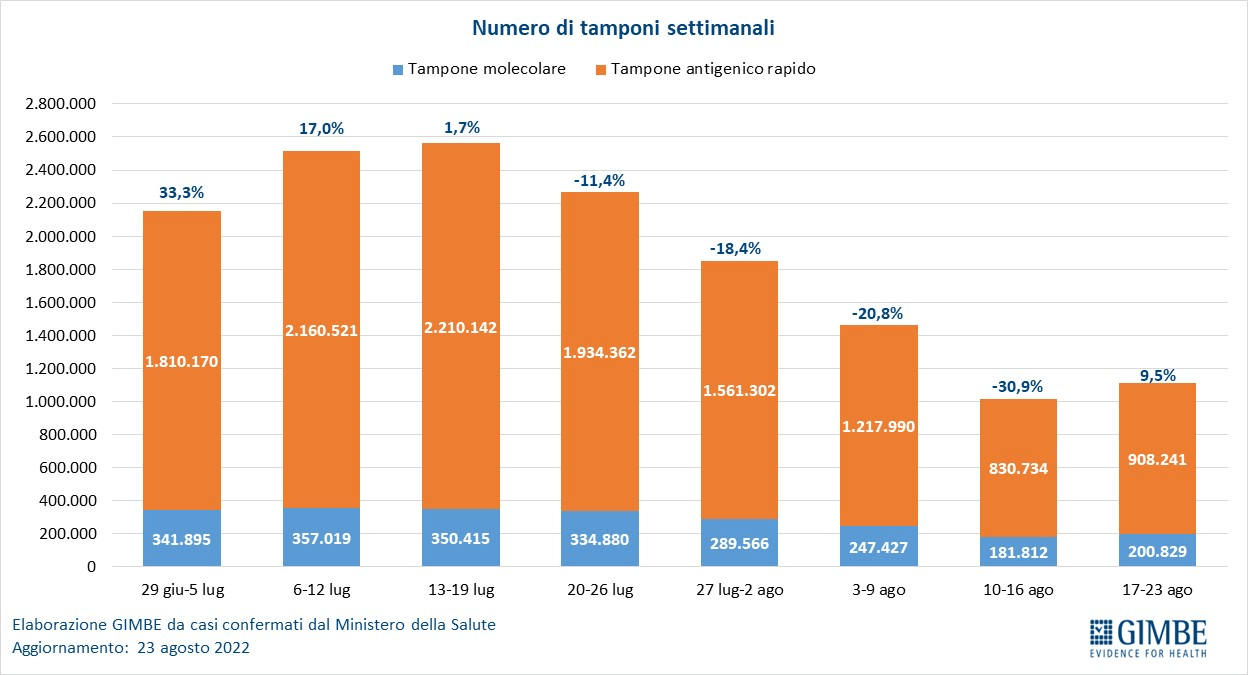
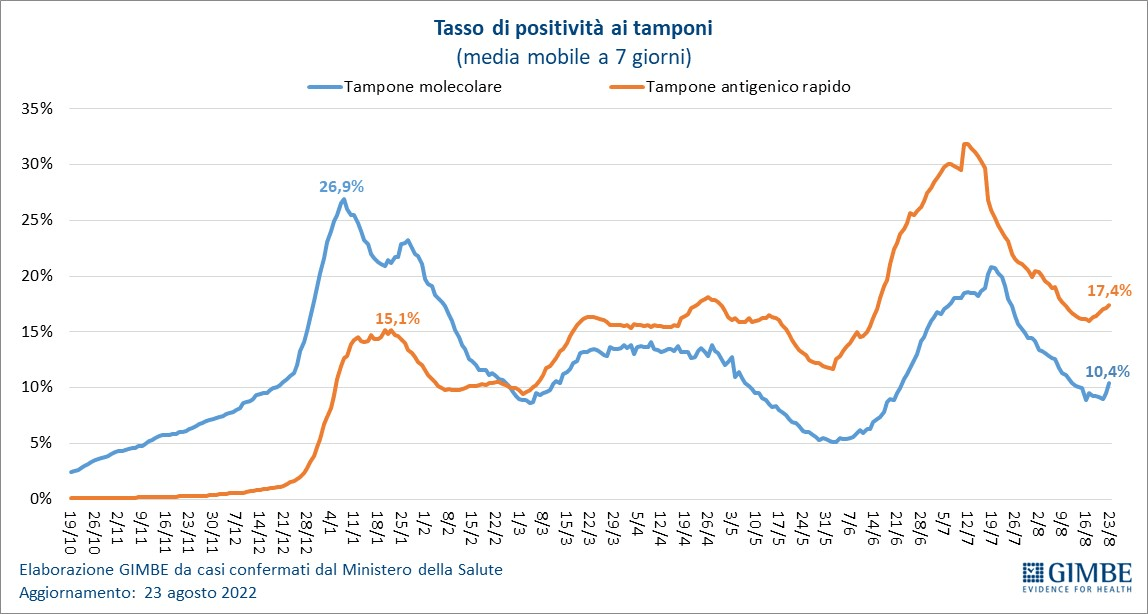
Hospitalizations. "On the hospital front – says Marco Mosti, Operations Director of the Gimbe Foundation – the decline in hospitalizations continues both in the medical area (-15.5%) and in intensive care (-15.1%)". From 26 July to 23 August, admissions fell from 434 to 254 in the critical area and from 11,124 to 6,378 in the medical area respectively (Figure 7). As of August 23, the national employment rate by COVID patients was 9.9% in the medical area (from 4.9% in Piedmont to 24.3% in Umbria) and 2.8% in the critical area (from 0% of the Autonomous Province of Bolzano and Valle D'Aosta to 5.6% of Calabria) (figure 8). "Intensive care admissions remain stable – points out Mosti – with a 7-day moving average of 23 admissions / day compared to 25 in the previous week" (Figure 9).
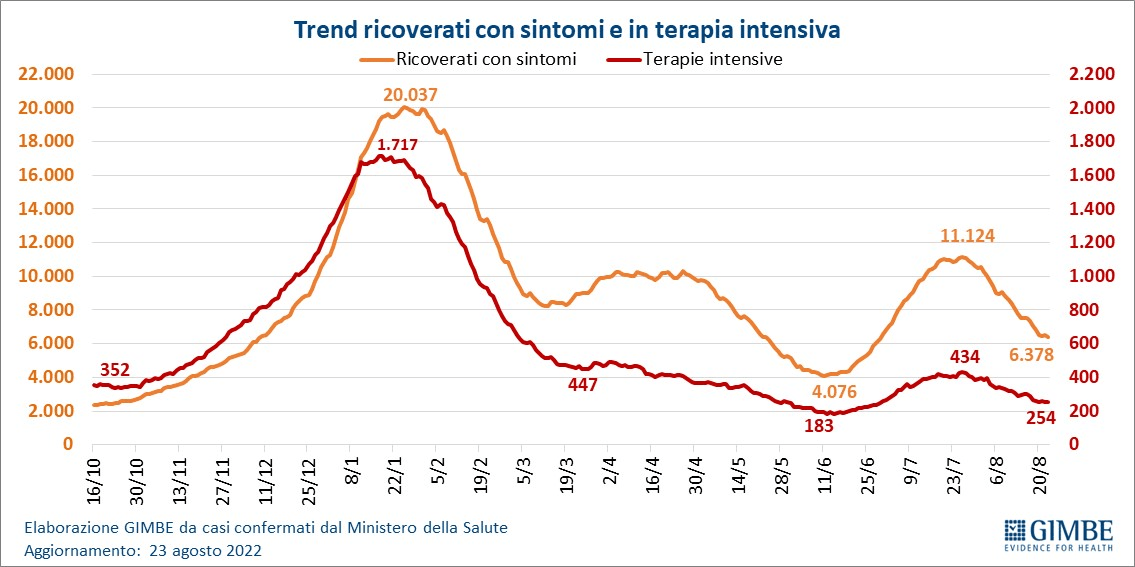
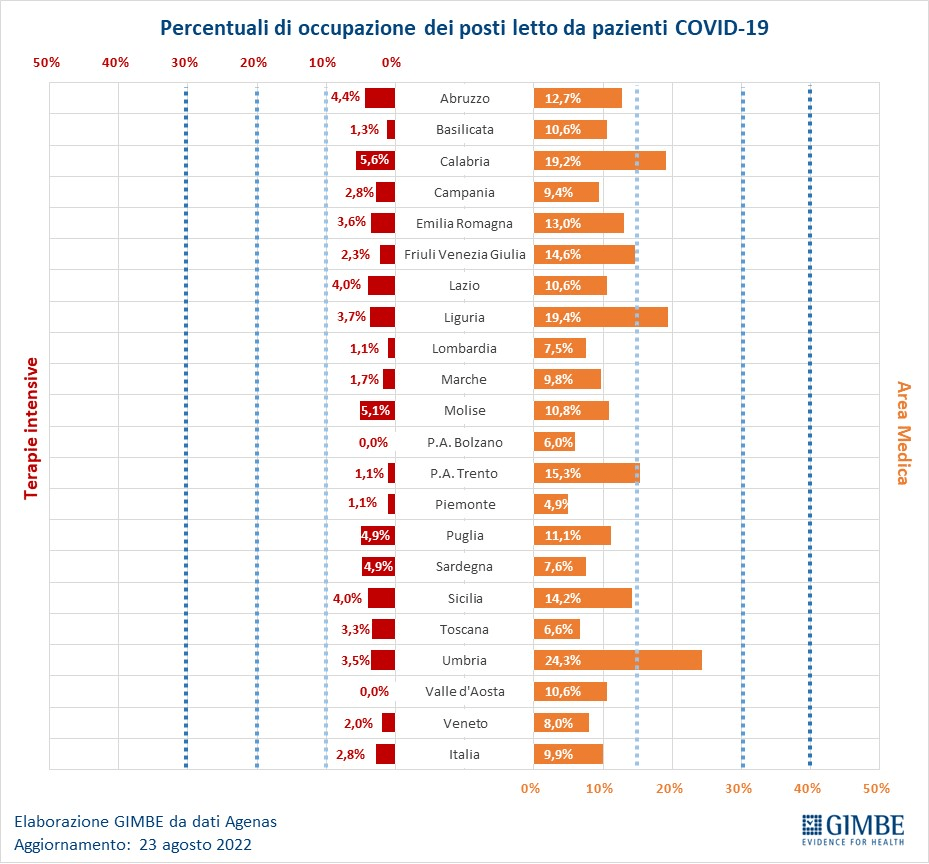
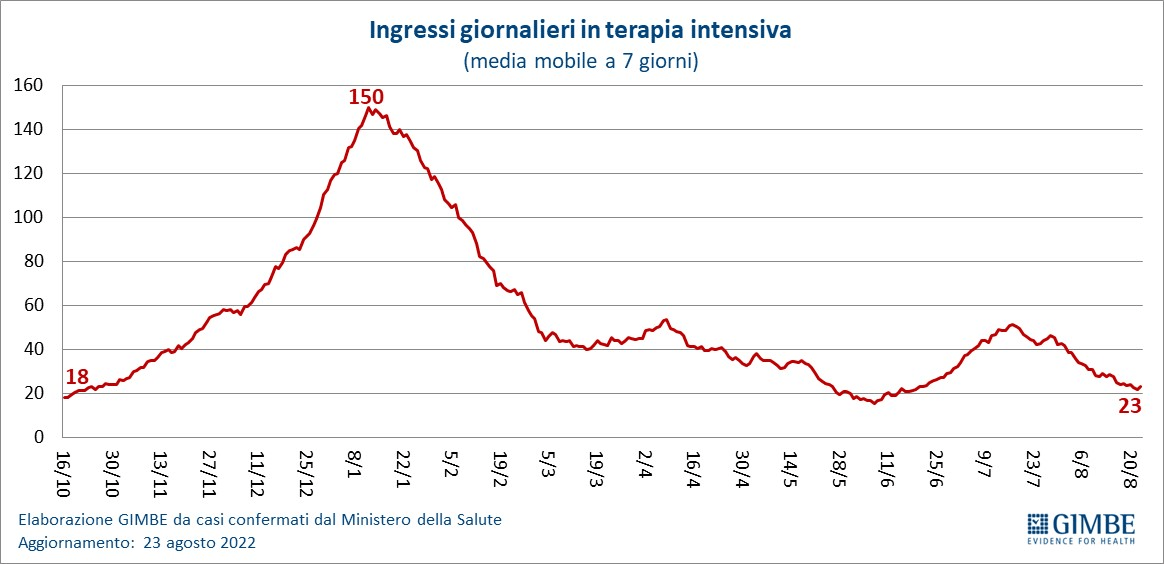
Deaths . Substantial stability is also recorded on the death front: 759 in the last 7 days (of which 80 referring to previous periods), with an average of 108 per day compared to 107 in the previous week. "The number of deaths in our country – comments Cartabellotta – remains very high, fueling the debate on the criteria for defining COVID deaths and even the request for a medical commission to investigate COVID mortality in Italy". According to the data published by the latest report of the Istituto Superiore di Sanità , relating to the deaths of people diagnosed with COVID-19 between June 24 and July 24, 2022, the crude death rate per 100,000 people is much higher among the not vaccinated than among those vaccinated with three doses: 19.1 vs 5.3 for the 60-79 age group and 327.2 vs 48.2 for the over 80. However, in the face of this very high efficacy, in the over 60s who have completed the vaccination cycle with 3 doses, there is a progressive increase in the crude mortality rate (figure): in particular, after touching the minimum value for the deceased with a diagnosis of COVID-19 in the period 20 / 05-19 / 06 in just over a month it increased from 1.5 to 5.3 in the 60-79 age group (+ 253%) and from 11.8 to 48.2 in the over 80s (+ 309%).
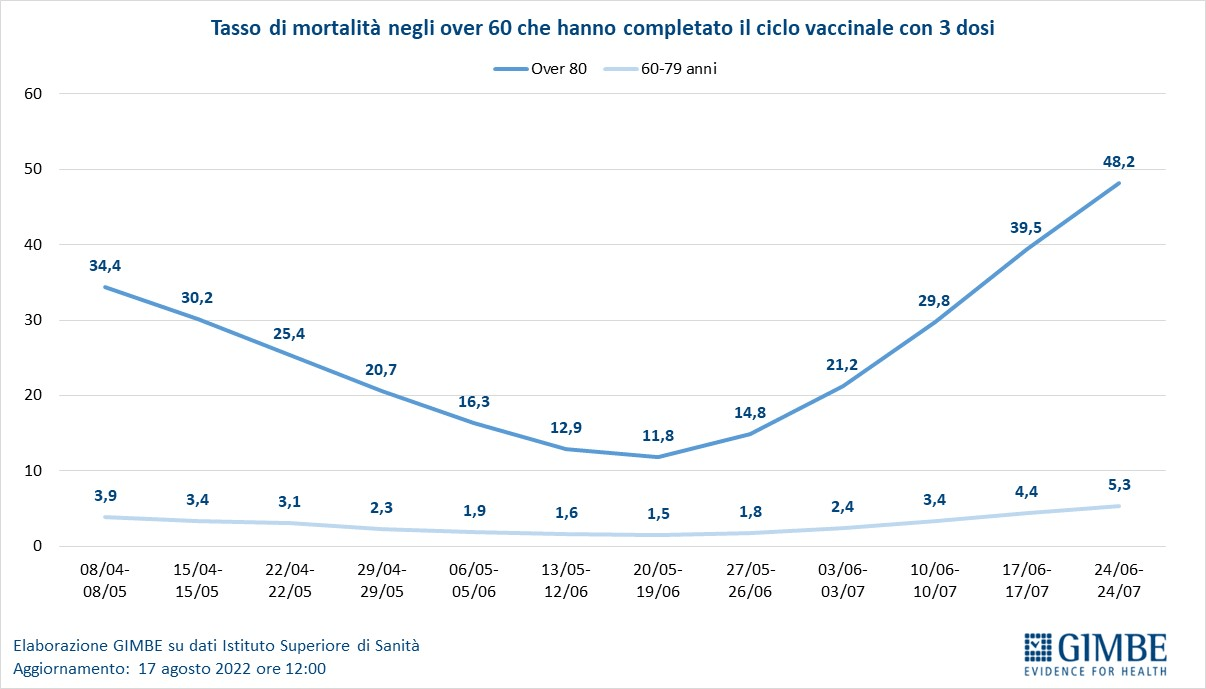
"The current number of deaths – explains the President – in particular in the over 80s is therefore strongly conditioned both by viral circulation and by the progressive decline of vaccination protection against serious illness after 120 days from the third dose, regardless of other variables such as comorbidities , under-use of antiviral drugs, organizational problems, criteria for defining COVID death ».
Vaccines: administrations. As of August 24 (update 06.16) 88.2% of the audience (n.50.826.033) had received at least one dose of vaccine (+1.693 compared to the previous week) and 86.7% (n.49.961. 891) completed the vaccination cycle (+1.936 compared to the previous week).
Vaccines: new vaccinated. In the week 17-23 August, the new vaccinates increased: 1,760 compared to 1,527 in the previous week (15.3%). Of these, 34.9% is represented by the 5-11: 614 range, with an increase of 45.2% compared to the previous week. Among the over 50s, who are more at risk of serious illness, the number of new vaccinates is down to 467 (-12.9% compared to the previous week) (figure 10).
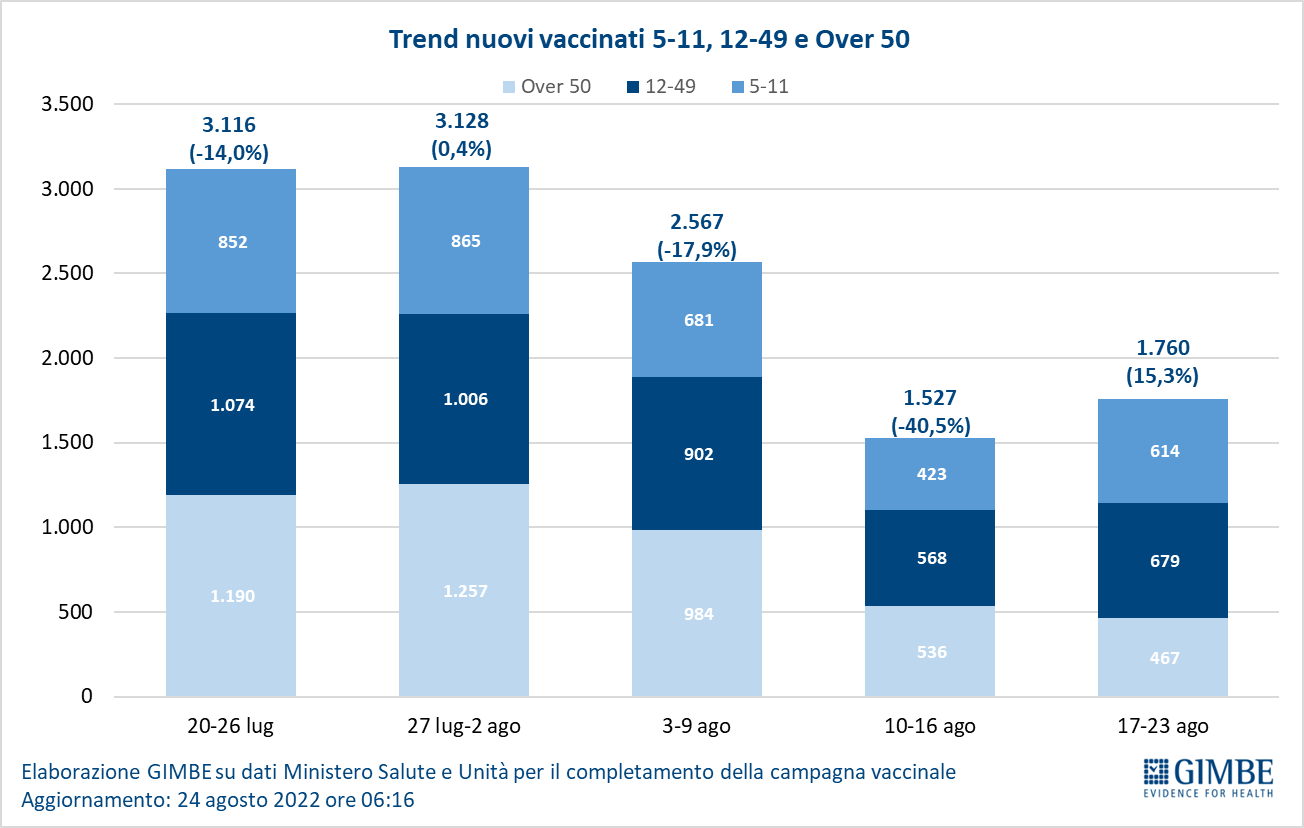
Vaccines: unvaccinated people. As of 24 August (updated 06.16), 6.82 million people over the age of 5 have not received even a dose of the vaccine (Figures 11 and 12), of which:
- 5.51 million currently vaccinated, equal to 9.6% of the audience with clear regional differences (from 6.8% in Lazio to 13.5% in Valle D'Aosta);
- 1.31 million temporarily protected as they recovered from COVID-19 for less than 180 days, equal to 2.3% of the audience with clear regional differences (from 1.4% in the Aosta Valley to 3.6% in the Province Autonomous of Bolzano).
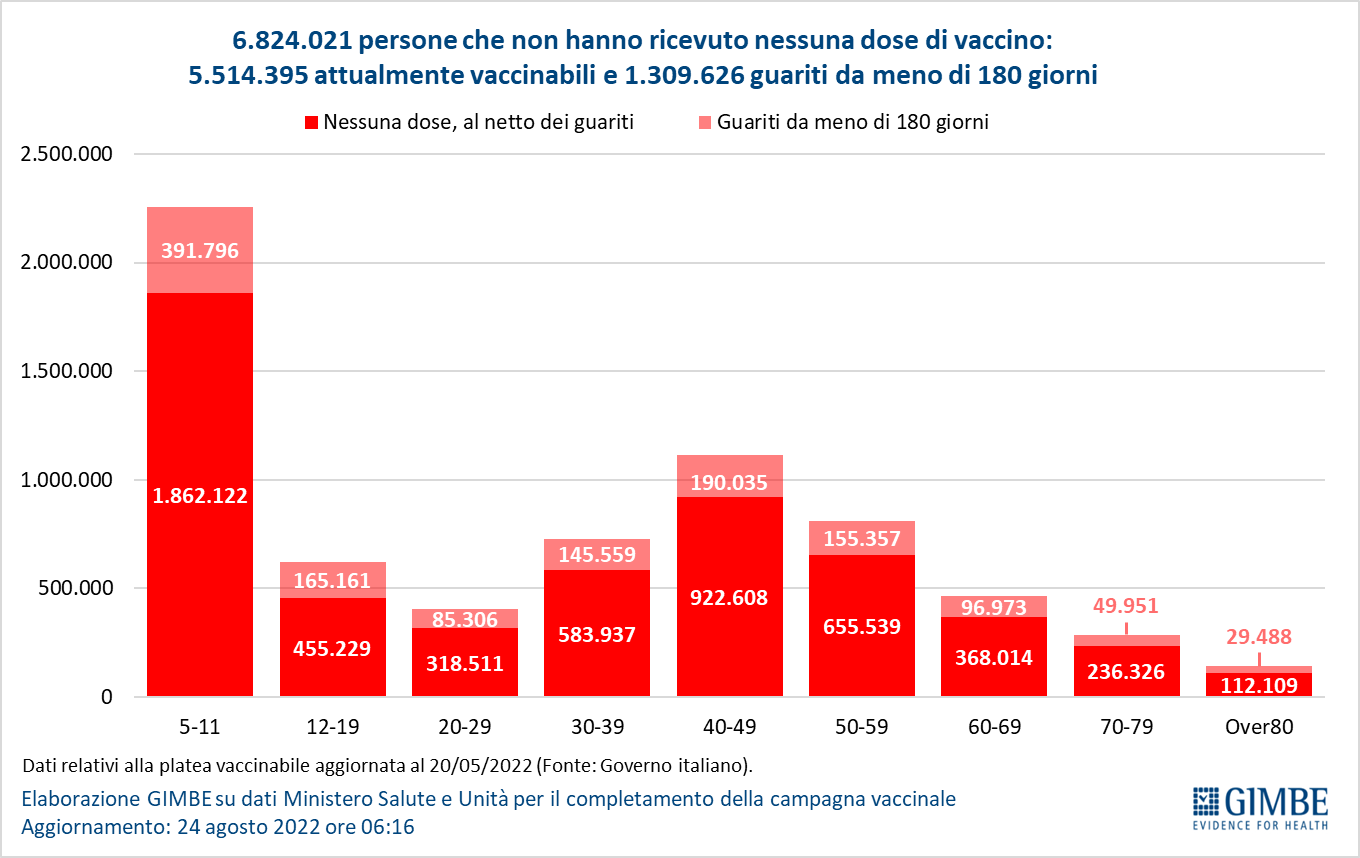
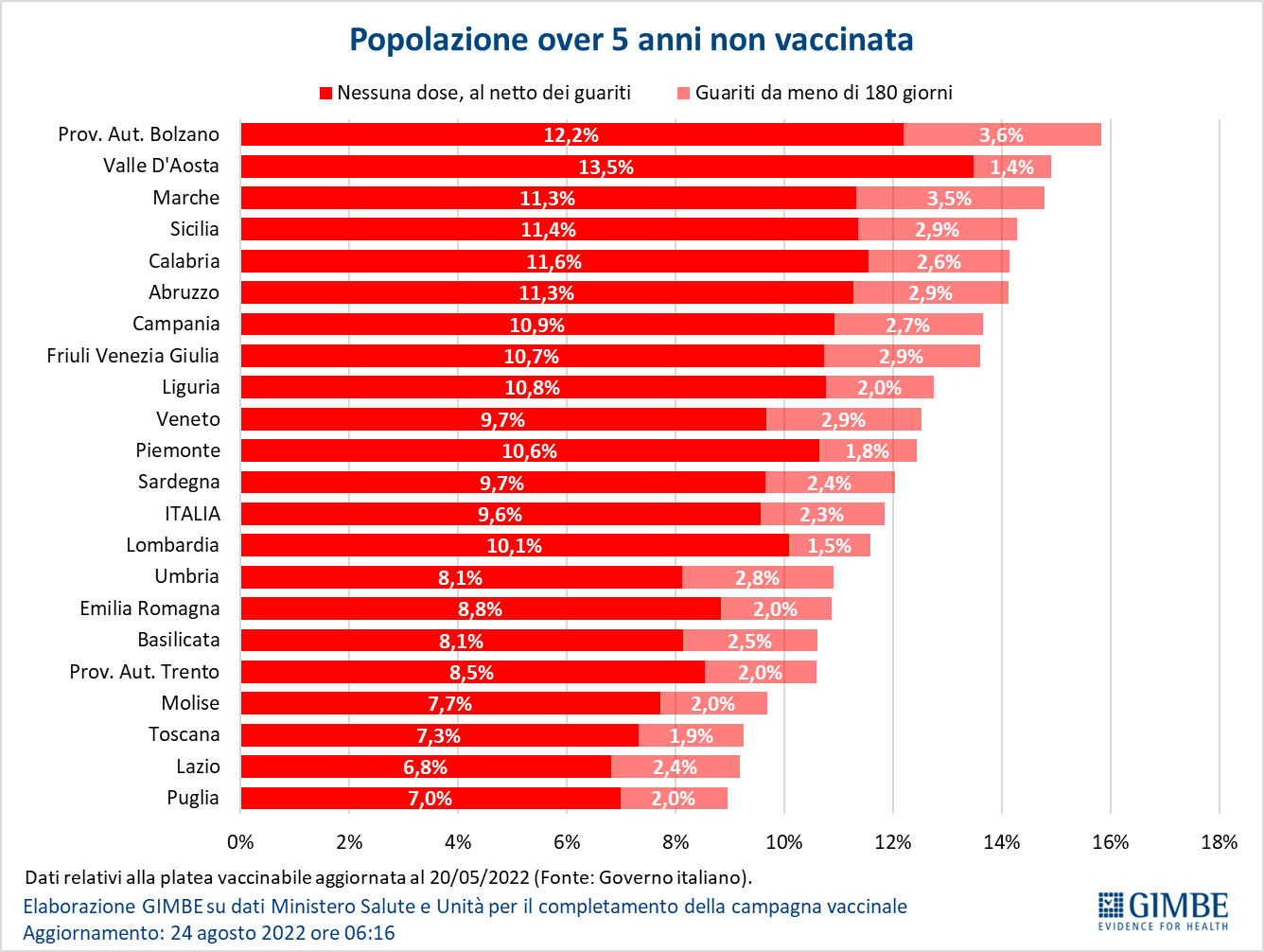
Vaccines: age range 5-11. As of August 24 (update 06.16) in the 5-11 year range 2,594,977 doses were administered: 1,402,151 received at least 1 vaccine dose (of which 1,282,213 completed the vaccination cycle), with a coverage rate national to 38.4% with clear regional differences: from 21% of the Autonomous Province of Bolzano to 53.9% of Puglia (figure 13).
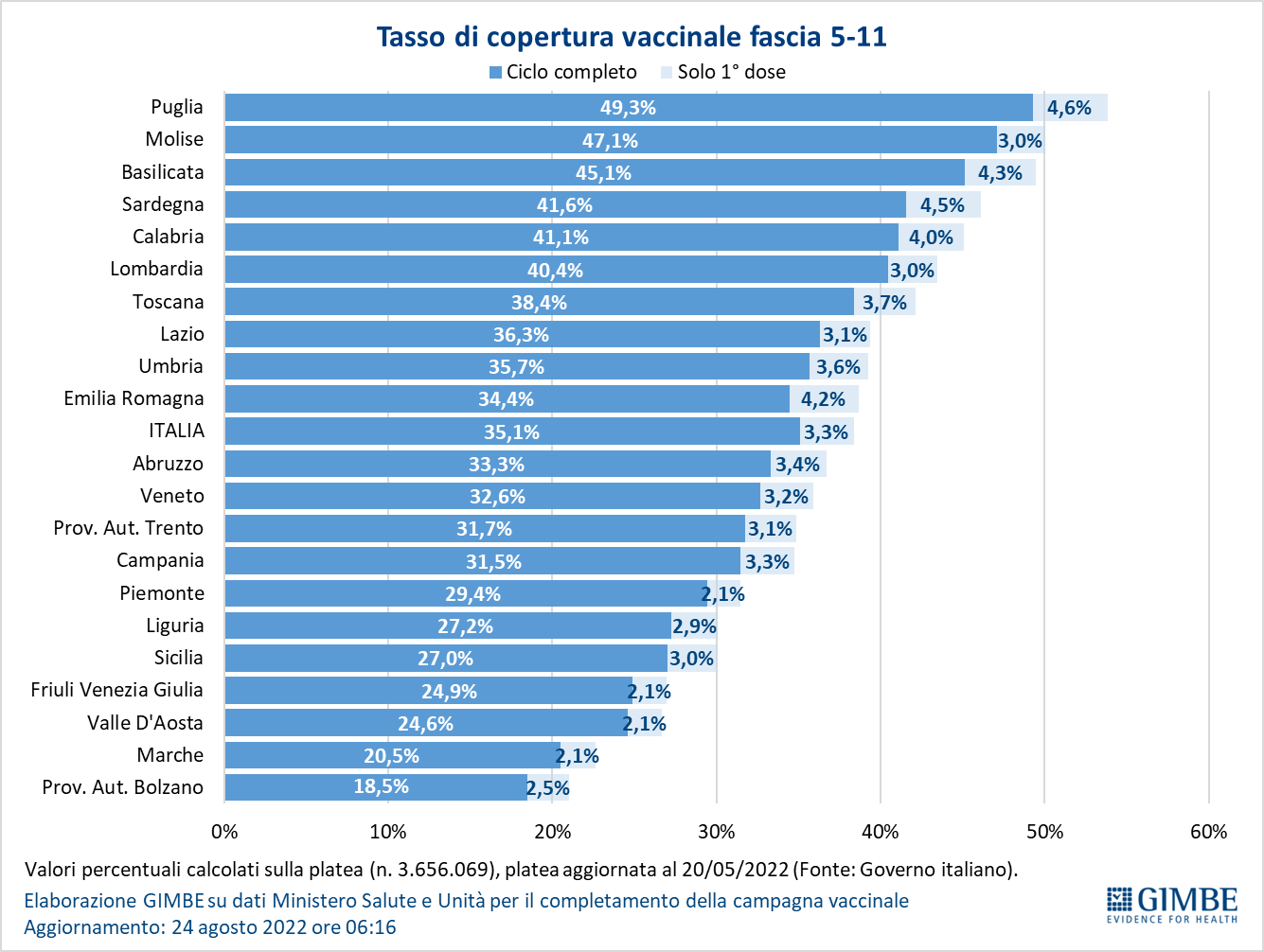
Vaccines: third dose. As of August 24 (update 06.16) 40,069,724 third doses were administered with a 7-day moving average of 2,668 administrations per day. According to the official audience (no. 47,703,593), updated as of May 20, the national coverage rate for third doses is 84%: from 78.2% in Sicily to 87.9% in Lombardy. 7.63 million people have not yet received the booster dose (Figures 14 and 15), of which:
- 5.08 million can receive it immediately, equal to 10.6% of the audience with clear regional differences (from 7.8% in Lombardy to 16.8% in Sicily);
- 2.56 million cannot receive it immediately as they have been healed for less than 120 days, equal to 5.4% of the audience with clear regional differences (from 2.7% in Valle D'Aosta to 7.9% in Abruzzo ).
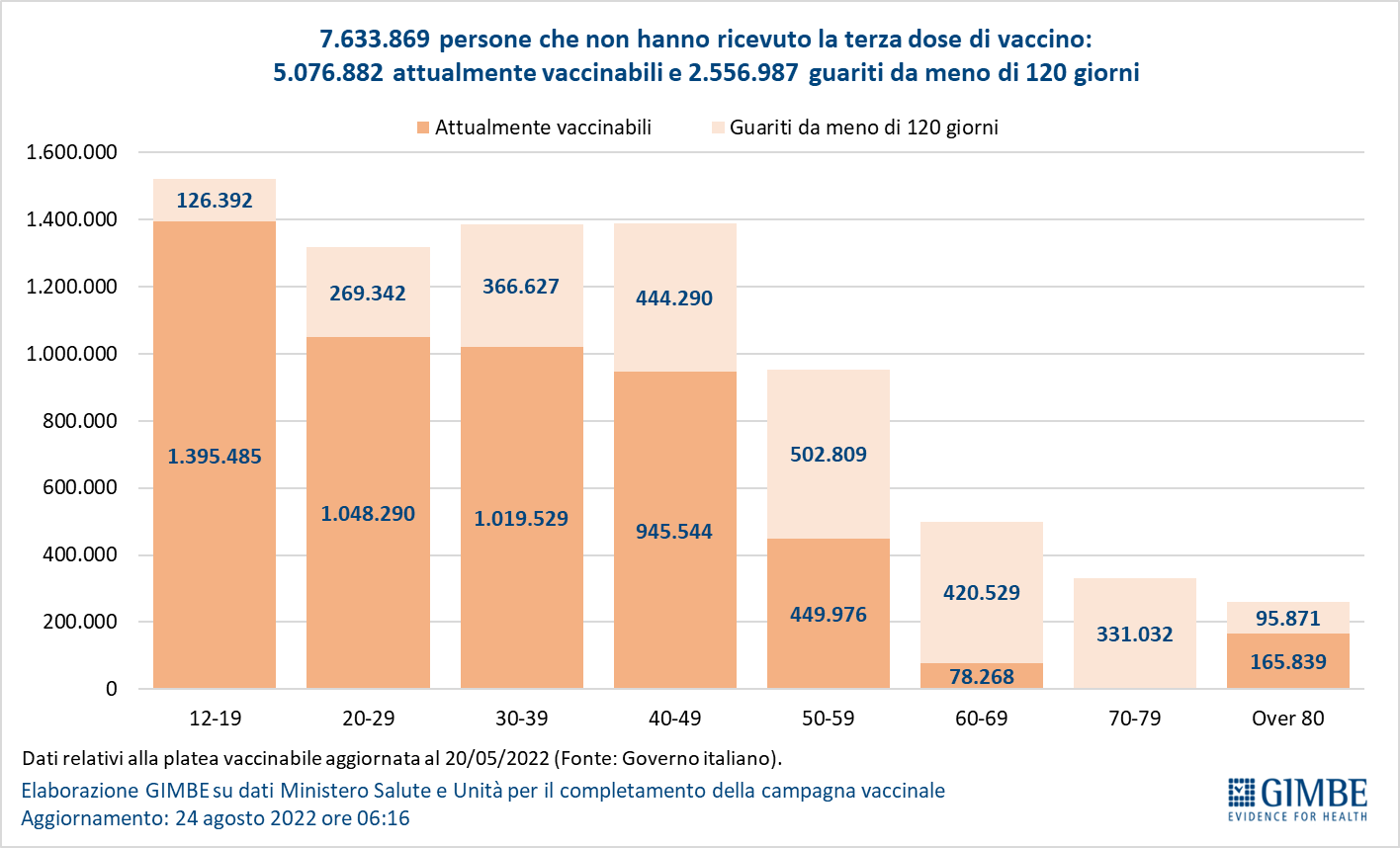
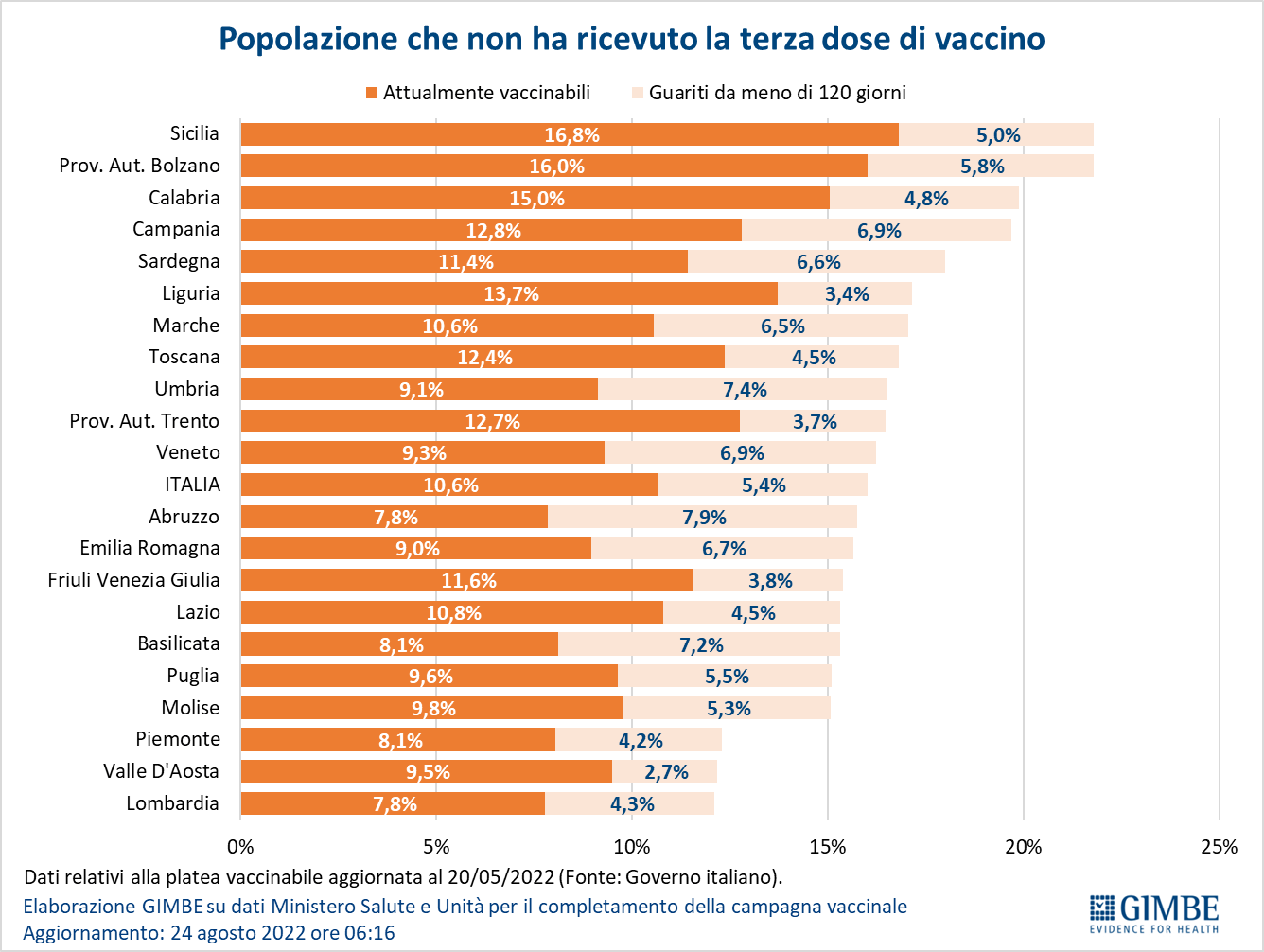
Vaccines: fourth dose . According to the provisions of the Circular of the Ministry of Health of 11 July 2022 , the number of people who are candidates to receive the second booster (fourth dose) – to be carried out at least 120 days after the third dose (first booster) or post third dose infection – is more than 17.1 million people, of which more than 1.85 million are immediately ineligible as they have recovered for less than 120 days. As of August 24 (update 06.16) 2,185,380 fourth doses were administered, with a moving average of 9,999 doses per day, down from 11,417 last week (-12.4%) (figure 16), and very far from the target of 100 thousand administrations set by the guidelines of the Unit for the completion of the vaccination campaign . According to the official audience (17,140,056 of which 5,480,919 of the 60-69 age group, 4,425,006 of the 70-79 age group, 3,691,879 of over 80, 3,454,153 of frail patients and 88,099 of guests of the RSAs that do not fall into the previous categories), updated to 27 July, the national coverage rate for the fourth doses is 16.7% with clear regional differences: from 6.4% in the Autonomous Province of Bolzano to 32.3% of Piedmont (figure 17).
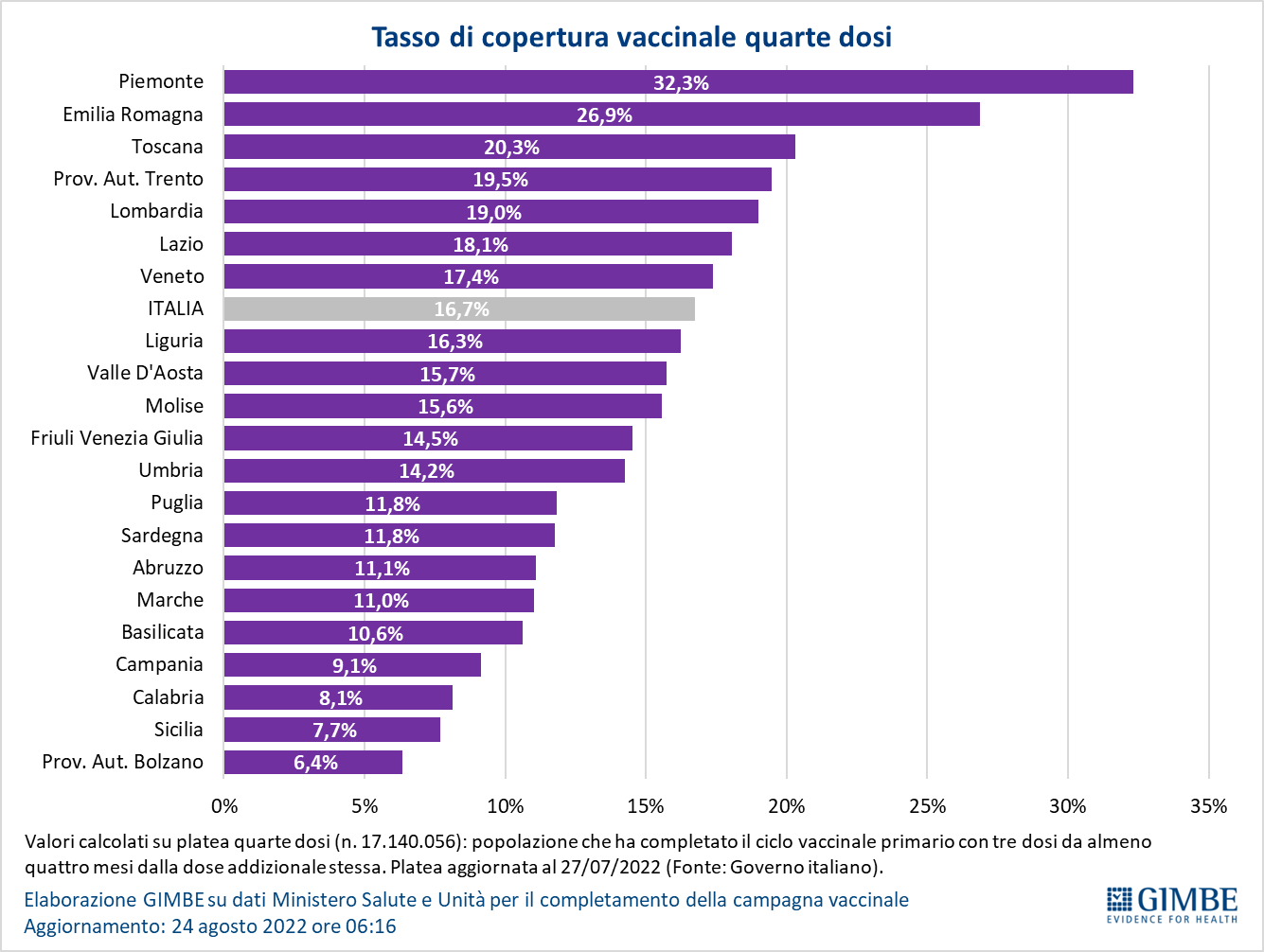
«If in the electoral campaign – concludes Cartabellotta – which monopolized public information, the pandemic found a place only for political exploitation, the data show that we are facing the autumn-winter season in an unfavorable situation. First of all, the descent of the fifth wave seems to have stopped and in the height of summer the viral circulation is still very high compared to previous years: as of August 23, over 750,000 positives (a number widely underestimated), a positivity rate of antigenic swabs at 17.4 % and an average of over 25,000 new cases per day. Secondly, the population at risk of serious illness is very large: as of 24 August, taking into account over 60 and frail, gross of temporarily protected people recovered, there are 893,000 unvaccinated, 1.91 million without a third dose and 14.3 million without fourth dose whose administration campaign suffers a sensational delay. Finally, no preparation plan has yet been made public for the autumn-winter season, strongly advocated by the Gimbe Foundation in the wake of the recommendations of the WHO Europe : to increase vaccination coverage (with three doses) in the general population; offer the fourth dose to people at risk 120 after the administration of the third; promote the use of masks indoors and on public transport; ventilate crowded public spaces, such as schools, offices, bars and restaurants, public transport; apply rigorous therapeutic protocols for people at risk of serious illness. In the absence of certainty about when the new Executive will be fully operational, the real risk is that of being in the middle of the autumn season chasing the virus for the umpteenth time, compromising the health and life of the most vulnerable people and delaying health care. for patients with other pathologies ".
This is a machine translation from Italian language of a post published on Start Magazine at the URL https://www.startmag.it/sanita/covid-allarme-fragili-in-autunno-report-gimbe/ on Thu, 25 Aug 2022 07:46:38 +0000.
